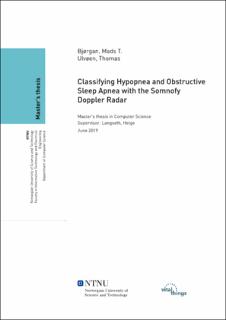| dc.contributor.advisor | Langseth, Helge | |
| dc.contributor.author | Bjørgan, Mads T. | |
| dc.contributor.author | Ulvøen, Thomas | |
| dc.date.accessioned | 2019-10-31T15:16:45Z | |
| dc.date.issued | 2019 | |
| dc.identifier | no.ntnu:inspera:36079153:34554464 | |
| dc.identifier.uri | http://hdl.handle.net/11250/2625810 | |
| dc.description.abstract | Somnofy, en Doppler-basert radar utviklet av VitalThings, undersøkes som metode for å gjenkjenne søvnapné og hypopné. Søvnrelaterte sykdommer diagnotiseres gjerne med polysomnografi, som er både kostbart i form av tid og ressurser. Det gir motivasjon for å undersøke om en høyst skalerbar portabel sensor, Somnofy, er anvendelig som et ledd i diagnotisering for å minske behovet for polysomnografi. Et konvolusjonalt nevralt nettverk er foreslått, som med 1-sekunds granularitet predikerer om apné eller hypopné forekommer med et 30-sekunders glidende vindu. Forskjellige teknikker for databalansering testes, og viktigheten av de ulike signalene kvantifiseres empirisk.
Den foreslåtte modellen er ikke presis nok til å bestemme på sekund-nivå når et event starter og slutter, men viser god overenstemmelse med apné-hypopné indekser. En foreslått hybrid teknikk for databalanserings har de beste empiriske resultatene. Okysgenmetning, pustedata og fysisk bevegelse er de viktigste signalene. Å bruke modellen til kliniske diagnoser er per dags dato ikke anbefalt, men modellen viser seg anvendelig i å anslå alvorlighetsgred av søvnapné. Videre validering og empirisk testing er anbefalt før foreslått modell anvendes. | |
| dc.description.abstract | The thesis explores whether Somnofy, a Doppler-based radar sensor, is applicable as a screening tool for subjects with possible sleep-disordered breathing. Sleep-disordered breathing is clinically diagnosed by a polysomnography study, which is costly both with regards to resources and time-consumption. It is therefore advantageous to investigate whether a highly scalable and portable radar sensor, such as Somnofy, can be used as a screening tool in order to reduce the usage of unnecessary PSG studies. A convolutional neural network is proposed, which provides predictions on a one-second granularity using a sliding window approach with a 30-second window. Various methods for treating data imbalance is investigated, and a feature importance study is conducted.
The proposed model is not precise enough to tell exactly when an event occurs but shows promising results for predicting the patients apnea-hypopnea index. A suggested hybrid sampling approach shows the most promising empirical results, while a feature importance study shows that oxygen saturation, respiration data, and physical movement are key features. Clinical application is not yet feasible, but the model shows promising and accurate results in assessing the severity of a possible diagnosis. Further validation and empirical testing are required before the proposed model is applicable for screening. | |
| dc.language | eng | |
| dc.publisher | NTNU | |
| dc.title | Klassifisering av Hypopné og Obstruktiv Søvnapné med Somnofy | |
| dc.type | Master thesis | |
